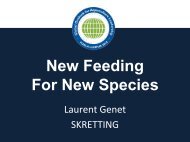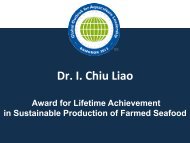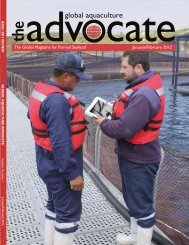May/June 2010 - Global Aquaculture Alliance
May/June 2010 - Global Aquaculture Alliance
May/June 2010 - Global Aquaculture Alliance
You also want an ePaper? Increase the reach of your titles
YUMPU automatically turns print PDFs into web optimized ePapers that Google loves.
production<br />
Large-scale shrimp operations in China with fully-lined, plastic-covered ponds are ideal for biofloc technology.<br />
Biofloc Technology Expanding<br />
At White Shrimp Farms<br />
Biofloc Systems Deliver High Productivity With Sustainability<br />
Summary:<br />
Biofloc technology provides high<br />
productivity, low feed-conversion<br />
ratios and a stable culture environment.<br />
Also, with viral problems<br />
and rising costs for energy, biofloc<br />
technology can help deliver sustainable<br />
production at lower cost.<br />
The basic requirements for biofloc<br />
system operation include high<br />
stocking density, high aeration<br />
and lined ponds. Pelleted grain<br />
and molasses are added to the<br />
culture water. A crucial factor is<br />
biofloc control during operation.<br />
Biofloc technology has become a popular<br />
technology in the farming of Pacific<br />
white shrimp, Litopenaeus vannamei. The<br />
basic technology was developed by Dr.<br />
Yoram Avnimelech in Israel and initially<br />
implemented commercially in Belize by<br />
Belize <strong>Aquaculture</strong>. It also has been<br />
Nyan Taw, Ph.D.<br />
General Manager<br />
Senior Technical Advisor<br />
Blue Archipelago BDH<br />
T3-9, KPMG Tower, 8 First Avenue<br />
Persiaran Bandar Utama, 47800<br />
Petaling Jaya, Selangor, Malaysia<br />
nyan.taw@bluearchipelago.com<br />
applied with success in shrimp farming in<br />
Indonesia and Australia. The combination<br />
of two technologies, partial harvesting<br />
and biofloc, has been studied in<br />
northern Sumatra, Indonesia.<br />
Biofloc Technology<br />
Biofloc is defined as macroaggregates<br />
composed of diatoms, macroalgae, fecal<br />
pellets, exoskeleton, remains of dead<br />
organisms, bacteria and invertebrates. It<br />
is possible this microbial protein has a<br />
higher availability than feed protein.<br />
The basic requirements for biofloc<br />
system operation include high stocking<br />
density with 130-150 PL10/m 2 and high<br />
aeration of 28 to 32 hp/ha with correct<br />
paddlewheel position in ponds. Ponds<br />
must be lined with concrete or highdensity<br />
polyethylene (HDPE), and pelleted<br />
grain and molasses are added to<br />
the culture water. Shrimp production of<br />
20-25 mt/ha/crop is normal for biofloc<br />
systems. A maximum production of<br />
nearly 50 mt/ha was achieved in small<br />
ponds in Indonesia.<br />
A crucial factor in the system is the<br />
control of bioflocs in ponds during operation.<br />
In raceways, settable solids wastes<br />
are removed outside the raceway. However,<br />
in large ponds, paddlewheel aerators<br />
need to be positioned to concentrate solid<br />
waste at the pond center for draining or<br />
other area for siphoning out. The suspended<br />
bioflocs are maintained at less<br />
than 15 mL/L during operation. The<br />
carbon:nitrogen ratio is controlled and<br />
kept over 15:1 by adjusting molasses,<br />
grain and feed inputs.<br />
Smaller, concrete-lined ponds apply biofloc technology in Bali, Indonesia.<br />
Commercial Interest<br />
Commercial interest in biofloc technology<br />
is threefold, for bioflocs provide<br />
high productivity, low feed-conversion<br />
ratios (FCRs) and a stable culture environment.<br />
Also, with emerging viral problems<br />
and rising costs for energy, biofloc<br />
technology appears to be an answer for<br />
sustainable production at lower cost.<br />
The technology has not only been<br />
applied at commercial shrimp growout<br />
farms, but also in super-intensive raceways<br />
to produce more than 9 kg shrimp/<br />
m 3 . The raceway applications have supported<br />
nursery and growout to shrimp<br />
broodstock rearing and selection of family<br />
lines. Presently, a number of studies by<br />
major universities and private companies<br />
are using biofloc as a protein source in<br />
shrimp and fish feeds.<br />
Applications<br />
The number of shrimp farms currently<br />
using biofloc technology is not<br />
known, but some prominent examples are<br />
Belize <strong>Aquaculture</strong>, Ltd., in Belize and<br />
P.T. Central Pertiwi Bahari in Indonesia.<br />
The success or failure of the technology is<br />
mainly due to the degree of understanding<br />
of basic concepts of the technology in<br />
commercial application.<br />
Belize <strong>Aquaculture</strong> was the first commercial<br />
farm to use biofloc technology<br />
successfully. Its production of 13.5 mt<br />
shrimp/ha was quite an achievement at<br />
the time. The Belize technology was<br />
applied initially in Indonesia at C.P.<br />
Indonesia (now P.T. Central Pertiwi<br />
Bahari, C.P. Indonesia), which achieved<br />
average production over 20 mt/ha in<br />
commercial 0.5-ha lined ponds. Research<br />
trials reached 50 mt/ha.<br />
The technology combined with partial<br />
harvest was repeated in Medan, Indonesia,<br />
with better results. During 2008<br />
and 2009, biofloc technology was used in<br />
Java and Bali successfully. In Indonesia,<br />
biosecurity protocols were incorporated<br />
within the technology.<br />
Most Indonesian shrimp farmers are<br />
interested in biofloc technology, but with<br />
some reservations, as a number of projects<br />
have failed due to incomplete understanding<br />
of the technology. For example,<br />
the correct number and position of paddlewheel<br />
aerators used in ponds are<br />
essential.<br />
The main objectives for paddlewheel<br />
aerators are to keep bioflocs in suspension.<br />
This can be achieved with informal aeration,<br />
but with no mechanism to concentrate<br />
solid waste for removal, high levels of<br />
suspended biofloc biomass can lead to<br />
deterioration of pond water quality. Even-<br />
Karang Asem Singaraja<br />
Pond A2 A3 B1 B2 B3 C1 C2 C3 B4 B4<br />
Pond size<br />
Stocking density<br />
Days of culture<br />
Survival (%)<br />
Average body weight<br />
Feed-conversion ratio<br />
Harvest/pond<br />
Harvest/ha<br />
24 <strong>May</strong>/<strong>June</strong> <strong>2010</strong> global aquaculture advocate global aquaculture advocate <strong>May</strong>/<strong>June</strong> <strong>2010</strong> 25<br />
2,600 m 2<br />
129/m 2<br />
125<br />
91<br />
20.57<br />
1.3<br />
6.23 mt<br />
23.97 mt<br />
2,500 m 2<br />
134/m 2<br />
125<br />
84<br />
20.12<br />
1.42<br />
5.69 mt<br />
22.78 mt<br />
Shrimp Production (kg/ha)<br />
60,000<br />
50,000<br />
40,000<br />
30,000<br />
20,000<br />
10,000<br />
0<br />
Figure 1. Shrimp production levels at various farms implementing biofloc technology.<br />
Table 1. Performance of shrimp farms in Bali, Indonesia, using biofloc technology.<br />
2,000 m 2<br />
167/m 2<br />
126<br />
93<br />
18.18<br />
1.36<br />
5.64 mt<br />
28.22 mt<br />
Belize Lampung, Medan, Java, Bali,<br />
Indonesia Indonesia Indonesia Indonesia<br />
2000 2003-05 2008 2008 2009<br />
Commercial Output Maximum Record<br />
2,000 m 2<br />
167/m 2<br />
91*<br />
62<br />
12.19<br />
1.45<br />
2.49 mt<br />
12.46 mt<br />
2,000 m 2<br />
167/m 2<br />
125<br />
85<br />
18.55<br />
1.44<br />
5.25 mt<br />
26.23 mt<br />
600 m 2<br />
152/m 2<br />
147<br />
92<br />
24.15<br />
1.61<br />
2.02 mt<br />
33.64 mt<br />
600 m 2<br />
152/m 2<br />
135<br />
89<br />
21.14<br />
1.52<br />
1.72 mt<br />
28.75 mt<br />
600 m 2<br />
152/m 2<br />
147<br />
91<br />
24.27<br />
1.58<br />
1.94 mt<br />
32.36 mt<br />
2,500 m 2<br />
152/m 2<br />
147<br />
85<br />
24.39<br />
1.63<br />
6.30 mt<br />
25.21 mt<br />
2,500 m 2<br />
152/m 2<br />
147<br />
81<br />
24.39<br />
1.59<br />
6.00 mt<br />
24.02 mt





